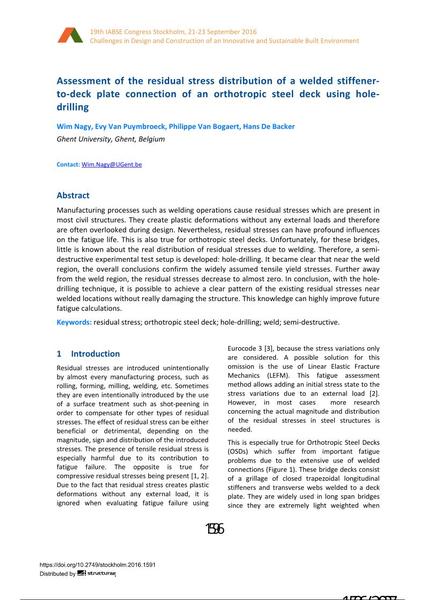Assessment of the residual stress distribution of a welded stiffener-to-deck plate connection of an orthotropic steel deck using hole-drilling

|
|
|||||||||||
Bibliografische Angaben
| Autor(en): |
Wim Nagy
(Ghent University, Ghent, Belgium)
Evy Van Puymbroeck (Ghent University, Ghent, Belgium) Philippe Van Bogaert (Ghent University, Ghent, Belgium) Hans De Backer |
||||
|---|---|---|---|---|---|
| Medium: | Tagungsbeitrag | ||||
| Sprache(n): | Englisch | ||||
| Tagung: | IABSE Congress: Challenges in Design and Construction of an Innovative and Sustainable Built Environment, Stockholm, Sweden, 21-23 September 2016 | ||||
| Veröffentlicht in: | IABSE Congress Stockholm, 2016 | ||||
|
|||||
| Seite(n): | 1596-1604 | ||||
| Anzahl der Seiten (im PDF): | 9 | ||||
| Jahr: | 2016 | ||||
| DOI: | 10.2749/stockholm.2016.1591 | ||||
| Abstrakt: |
Manufacturing processes such as welding operations cause residual stresses which are present in most civil structures. They create plastic deformations without any external loads and therefore are often overlooked during design. Nevertheless, residual stresses can have profound influences on the fatigue life. This is also true for orthotropic steel decks. Unfortunately, for these bridges, little is known about the real distribution of residual stresses due to welding. Therefore, a semi- destructive experimental test setup is developed: hole-drilling. It became clear that near the weld region, the overall conclusions confirm the widely assumed tensile yield stresses. Further away from the weld region, the residual stresses decrease to almost zero. In conclusion, with the hole- drilling technique, it is possible to achieve a clear pattern of the existing residual stresses near welded locations without really damaging the structure. This knowledge can highly improve future fatigue calculations. |
||||
| Stichwörter: |
orthotrope Stahlfahrbahn
|
||||
